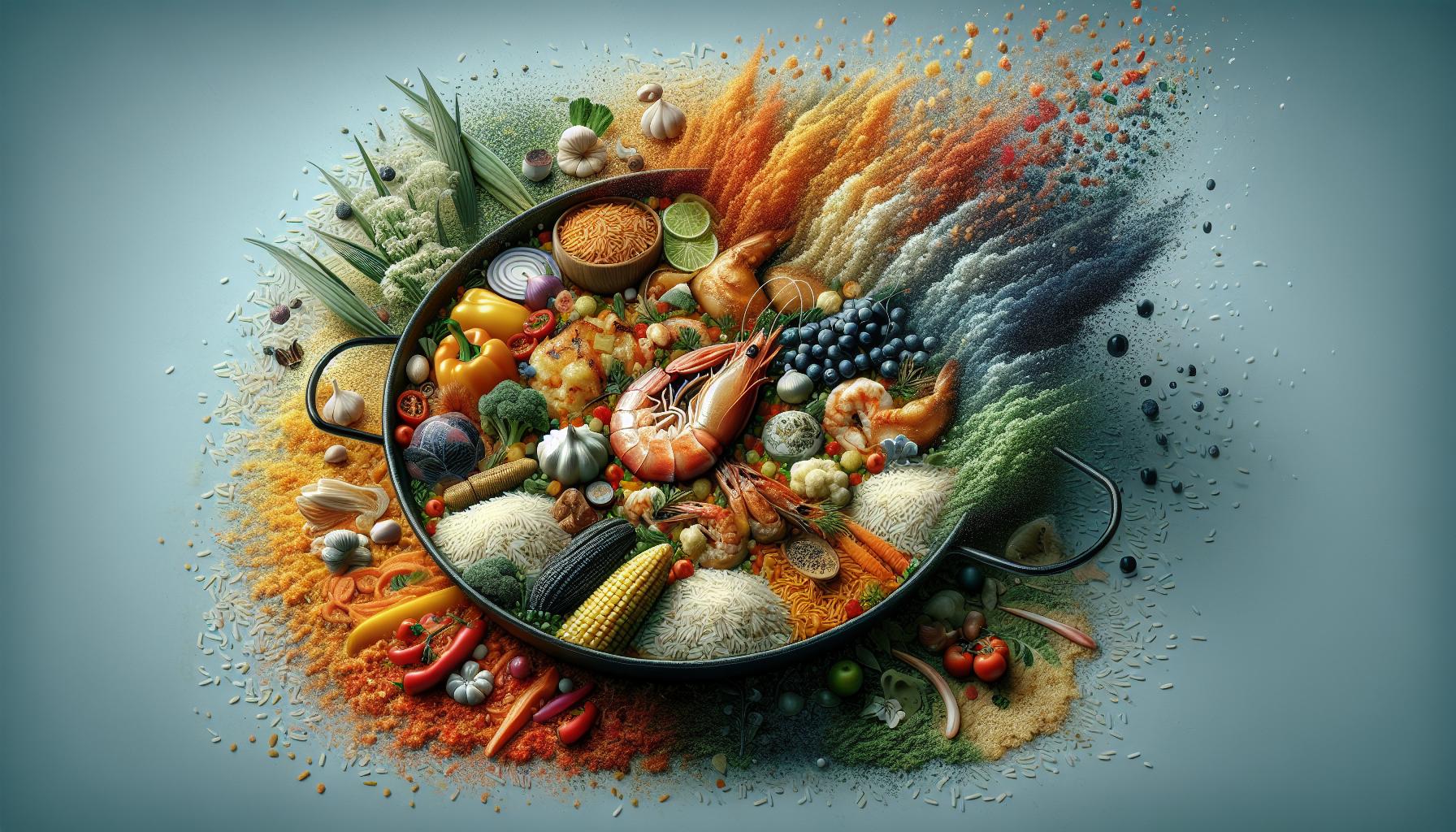Planning to whip up a flavorful paella but wondering if Basmati rice could be a suitable substitute? When it comes to this iconic Spanish dish, the choice of rice is crucial to achieving that perfect texture and flavor. While traditional paella recipes call for Bomba rice, a short-grain variety known for its ability to absorb liquid and create a delectable socarrat, you might be tempted to experiment with Basmati rice.
Basmati rice, with its long, slender grains and fragrant aroma, is a staple in many South Asian dishes. However, its distinct characteristics may not lend themselves well to the rich, savory flavors and creamy consistency that define a classic paella. To uncover whether Basmati rice can deliver the desired results in your paella recipe, we’ll delve into the key differences between these two rice varieties and explore the potential impact on the overall taste and texture of your dish.
Understanding the Role of Rice in Paella
Rice is the quintessential ingredient in paella, dictating its final taste and texture. Let’s delve into the essential aspects of rice when crafting this delectable Spanish dish.
For Beginners: Grasping the Basics
- Choose Bomba rice for traditional paella.
- Understand that rice’s ability to absorb flavors is crucial.
- Ensure the rice cooks evenly for a harmonious blend of ingredients.
For Intermediate Cooks: Elevating Your Dish
- Experiment with Calasparra rice for a unique twist.
- Master the technique of achieving the elusive “socarrat” – the prized crispy layer at the bottom.
- Adjust the rice-to-liquid ratio for a perfect, well-balanced paella.
- Explore unconventional rice varieties like Arborio or even Basmati for a fusion paella.
- Incorporate homemade fish or vegetable broth for a personalized touch.
- Infuse saffron threads early in the cooking process for a vibrant hue and rich flavor profile.
Key Takeaway: The type of rice you choose plays a pivotal role in the overall success of your paella masterpiece. Experimentation and fine-tuning are key to creating a dish that resonates with your palate and culinary creativity.
Exploring the Characteristics of Basmati Rice

Exploring the Characteristics of Basmati Rice
When considering using Basmati rice for paella, it’s essential to understand its unique characteristics and how they can influence the final dish. Let’s delve into the world of Basmati rice to see if it’s a suitable choice for your paella creation.
-
For Beginners: Mastering the Basics
- Basmati rice is known for its long, slender grains and fragrant aroma, adding a distinctive touch to your paella.
- Its fluffy texture and subtly nutty flavor can complement paella ingredients, especially seafood and aromatic spices.
- When using Basmati for paella, adjust the cooking method to ensure the rice retains its individual grains while absorbing the flavors of the dish.
-
For Intermediate Cooks: Enhancing Your Dish
- Consider the type of paella you’re making when using Basmati rice—it pairs well with lighter seafood or vegetable-based paellas.
- Experiment with toasting the Basmati rice before adding liquids to enhance its nuttiness and prevent clumping.
- Be mindful of the cooking time and liquid ratios to achieve the desired al dente texture typical of paella with Basmati rice.
- Blend Basmati rice with other short-grain varieties like Bomba for a unique flavor and texture profile in your paella.
- Infuse Basmati rice with saffron and other traditional paella spices to create a fusion dish that combines Indian and Spanish culinary elements.
- Explore different cooking methods such as using a paella pan or traditional Indian cookware to add depth to your Basmati rice paella.
Incorporating Basmati rice into your paella opens up a world of possibilities, allowing you to create a dish that marries the flavors of different culinary traditions. Experiment, adapt, and savor the journey of crafting a paella that reflects your creativity and expertise.
The Significance of Rice Varieties in Paella
For Beginners: Understanding the Basics
- Different rice varieties bring unique flavors and textures to paella.
- Short-grain rice, like Bomba or Arborio, is ideal for absorbing broth and retaining firmness.
- Medium- or medium-short grain rice, such as Calasparra or Balilla x Sollana, offers a balance of creaminess and absorption.
- Long-grain rice, like Basmati, brings a distinct aroma and individual grain structure.
For Intermediate Cooks: Enhancing Your Dish
- Toasting the rice before adding liquid can deepen the flavor and enhance texture.
- Mixing rice varieties, such as combining Bomba with Basmati, can create a unique mouthfeel and flavor profile.
- Experiment with infusing saffron into the rice for a traditional touch and vibrant color.
- Incorporating different cooking methods, like using a traditional paella pan or a cast-iron skillet, can add diversity to your dishes.
- Dive into heritage rice varieties to explore traditional flavors and adapt them to modern paella recipes.
- Consider seasonal ingredients to elevate the taste and freshness of your paella.
- Explore regional variations of paella to understand the diversity of rice usage in Spanish cuisine.
- Customize your blend of rice to tailor texture and flavor based on the protein and spices used in your paella.
Rice Varieties Play a Vital Role in Crafting the Perfect Paella. Mixing and matching rice types can transform a simple dish into a culinary masterpiece, offering a spectrum of flavors and textures for every palate.
Can Basmati Rice Substitute Bomba Rice in Paella?
When it comes to paella, the choice of rice plays a crucial role in determining the dish’s texture, flavor, and overall dining experience. Basmati rice and Bomba rice are both exceptional varieties in their own right, each offering unique qualities to the dish. Let’s explore whether Basmati rice can effectively substitute Bomba rice in paella.
For Beginners: Choosing the Right Rice
- Basmati Rice: Known for its long, slender grains and aromatic properties, Basmati rice can be a suitable alternative for those new to paella cooking.
- Bomba Rice: A short-grain variety with excellent absorptive qualities, Bomba rice is traditionally preferred for paella due to its ability to soak up flavors without becoming mushy.
For Intermediate Cooks: Understanding the Impact
- Texture: Basmati rice tends to be more separate and fluffy when cooked, resulting in a lighter and less creamy paella compared to the creaminess achieved with Bomba rice.
- Flavor Absorption: Bomba rice absorbs liquid more efficiently than Basmati, ensuring a richer taste in every bite of paella.
- Blending Varieties: To achieve a balance between texture and flavor, consider blending Basmati with Bomba rice in your paella for a unique dining experience.
- Adjusting Cooking Techniques: Depending on your preference, fine-tune your cooking methods to enhance the characteristics of Basmati rice in the dish.
In my final thoughts, while Basmati rice can substitute Bomba rice in paella, it’s essential to consider the desired texture and flavor profile of the final dish. Experimenting with different rice varieties and techniques can lead to a personalized paella that caters to your preferences and culinary creativity.
Considerations for Using Basmati Rice in Your Paella

When considering whether to use Basmati rice for your paella, there are a few key points to keep in mind to ensure a successful outcome.
For Beginners: Mastering the Basics
- Basmati rice is known for its long grains and aromatic qualities, which can add a unique touch to your paella.
- It’s essential to adjust the cooking time and liquid ratios when using Basmati rice to ensure it reaches the desired texture without becoming mushy.
- Experiment with adding extra flavor agents such as saffron or smoked paprika to enhance the taste of Basmati rice in your paella.
For Intermediate Cooks: Enhancing Your Dish
- Consider blending Basmati rice with Bomba rice for a balance between texture and flavor absorption in your paella.
- Try toasting the Basmati rice before cooking to add a nutty flavor and improve its ability to absorb the paella’s flavors.
- Incorporate a variety of herbs and spices to elevate the taste profile of your Basmati rice paella, catering to more sophisticated palates.
- Experiment with different Basmati rice varieties to discover which one complements your paella the best, considering factors like grain length and aroma intensity.
- Fine-tune your cooking techniques by adjusting temperatures and cooking methods to achieve a perfect balance of tenderness and separation in the Basmati rice grains.
- Challenge traditional paella norms by incorporating innovative ingredients or techniques to create a truly unique and memorable Basmati rice paella dish that showcases your expertise.
Remember, the key to using Basmati rice in your paella lies in understanding its characteristics and adapting your cooking approach to make the most of its distinctive qualities. Experimentation is key to finding the perfect balance and creating a paella that suits your preferences and culinary creativity.
Conclusion
Incorporating Basmati rice into paella opens up a world of culinary possibilities. By adjusting cooking methods and flavor profiles, we can create a unique and personalized paella experience. Blending Basmati with Bomba rice, toasting it for enhanced flavor, and experimenting with different rice varieties can elevate the dish to new heights. Understanding Basmati’s characteristics is key to crafting a paella that reflects our individual tastes and preferences. With a touch of creativity and a dash of experimentation, we can transform a traditional dish into a culinary masterpiece that is truly our own.

